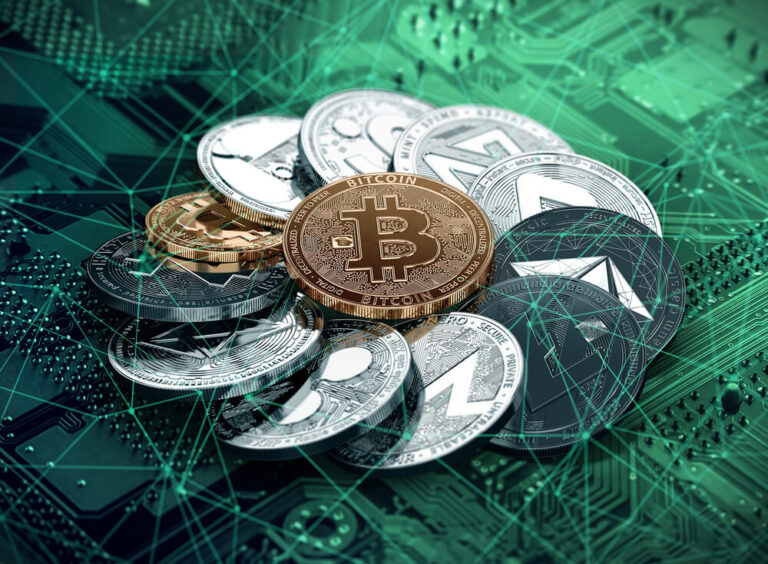2023 was nothing short of an eventful year, most importantly marked by defining moments accelerating innovation and adoption in the crypto industry. While 2022 was labeled as the year of meltdowns, 2023 was the year of consolidation and resilience.
We are thrilled to share our Year In Review ahead of our Market Outlook 2024. One of the major challenges of this report is turning it into a coherent story summarizing the year and heading it toward the future. If we had to define the year 2023, it would be split up into 7 key categories.

Grappling with inflation
In the last month of 2023, the US dollar hit a 4-month low amid anticipation of rate cuts in 2024. The Fed’s balance sheet increased by ~$2B since August. Moreover, Moody signaled negative indicators for the U.S. economy, lowering the credit rating from stable to negative. With $33.7 trillion in debt, a government shutdown dodged, many are afraid a recession may be underway in the case that the U.S. fails to honor its debt. Although Bitcoin’s bull run (up by ~160% year-over-year) leading up to the end of the year could have been triggered due to speculation around a potential spot ETF in the U.S., the weakening of credit ratings and sticky inflation strengthens Bitcoin’s narrative as a hedge against currency debasement.
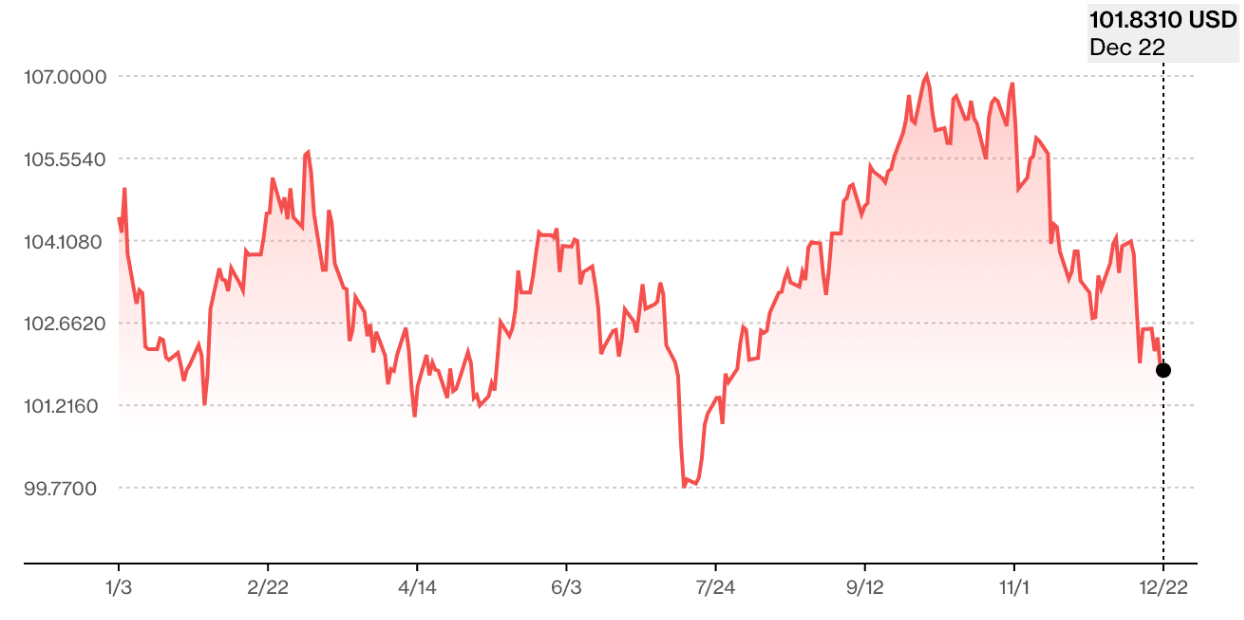
Still under the second-order effects of the Russo-Ukrainian war, the world was still grappling with soaring inflation in 2023, imposing rate hikes to keep consumer prices in order. In the eurozone, annual inflation cooled down to 2.4% in November, the lowest in 16 months. This cooling could be attributed to the easing of oil prices, as opposed to the oil crisis of 2022. In the U.S., inflation started the year above 6%, cooling down to 3.1% in November, with prices of products and goods (excluding food and energy) unchanged in two consecutive months from October and unemployment claims falling against predictions to 205K unemployment insurance applications on December 21.
Still below the 2% benchmark, we’re not out of the woods yet. In other economies, however, inflation is not holding back. For instance, the inflation rate in Argentina soared by over 160% in November. On the back of the devaluation of the Argentine peso, the data indicates that Argentinians are resorting to Bitcoin and U.S.-backed stablecoins as a hedge against the debasement of their peso. With three rate cuts expected in the US in 2024, elections in November, and an escalating war in the Middle East that has yet to impact oil prices, Bitcoin’s narrative has never been clearer to investors around the world as a hedge against wealth confiscation and counterparty risk.
Grayscale’s regulatory win: a potential spot ETF in the US
In June 2022, the Securities and Exchange Commission (SEC) rejected Grayscale’s request submitted in 2021, to convert its Bitcoin Trust into a spot ETF. On that occasion, Grayscale filed a petition challenging the decision with the U.S. Court of Appeals for the District of Columbia Circuit, for acting arbitrarily and capriciously by denying the listing of Grayscale’s proposed Bitcoin ETP and approving the listing of materially similar Bitcoin futures ETPs: Teucrium Bitcoin Futures Fund and Valkyrie XBTO Bitcoin Futures Fund.
The SEC’s longstanding argument was that spot Bitcoin applications were not “designed to prevent fraudulent and manipulative acts and practices” and failed to satisfy the significant market test. That was the case until August 2023, when the Court of Appeals ruled that “Grayscale advanced substantial evidence that its proposed bitcoin ETP was similar to the Teucrium and Valkyrie bitcoin futures ETPs and, therefore, should have received the same regulatory treatment.”
Grayscale proved to the court that there was a 99.9% correlation between Bitcoin’s spot market and CME futures contract prices. In addition, the listing exchanges for Grayscale and the Bitcoin futures ETPs have identical surveillance-sharing agreements with the CME, on which Bitcoin futures trade. The news spread excitement in the industry, increasing the total crypto market cap by 4% overnight. More specifically, the gap between the trading price of Grayscale Bitcoin Trust and its net asset value (NAV) significantly narrowed following the court ruling, falling by almost 16%, as shown in the figure below, witnessing its smallest discount in two years. As of December 20, GBTC’s NAV stood at -7.9%.

The news has also encouraged more issuers to come forward with their spot Bitcoin applications, a testament to the flows such a regulated product may bring, with institutional investors at the frontline of this market sentiment. Some have predicted that it may bring trillions into the crypto asset industry.
The burgeoning use cases of Bitcoin
2023 was the year the world witnessed how Bitcoin can expand its use cases beyond a store of value asset. Nevertheless, Bitcoin’s classic narrative as a hedge against counterparty risk was very visible this year, especially in March 2023, during the collapse of Silicon Valley Bank, Silvergate Bank, and First Republic in the U.S., pushing Bitcoin’s price by 40% to break the $30K mark after starting the year at ~$16.5K.
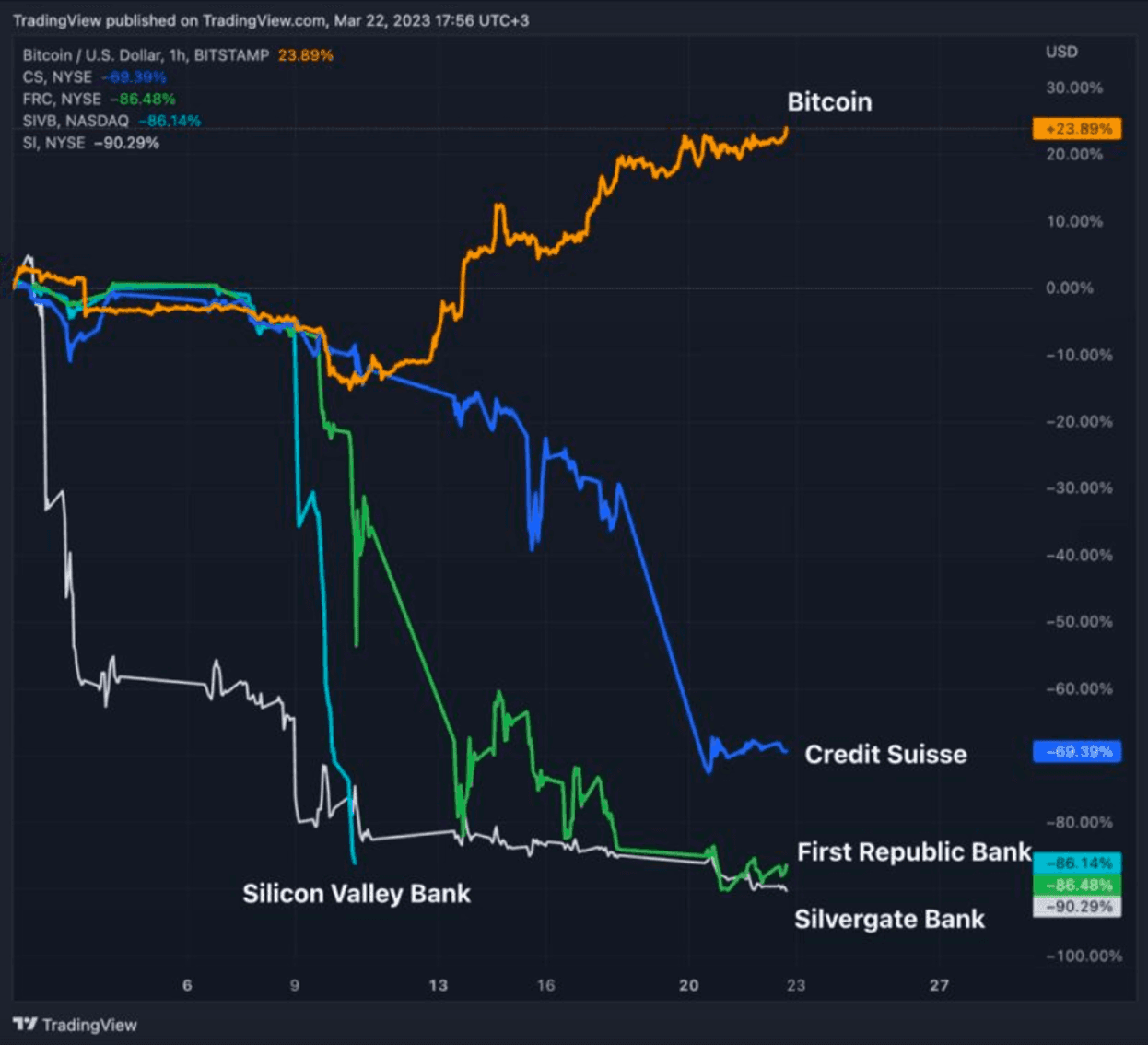
Moving away from macroeconomic factors impacting Bitcoin’s market sentiment, the fundamentals tying this network together grew exponentially throughout 2023. It all started at the end of 2022 when Casey Rodarmor inscribed an original pixel art of a black and white skull on the Bitcoin blockchain, marking the beginning of a new use case: storing images or strings of text on the network through Rodarmor’s “Ordinals,” which has made it possible to mint non-fungible tokens (NFTs) natively on the Bitcoin blockchain. By giving each atomic satoshi (1 BTC = 100 million satoshis) individual identities, Ordinals allow them to be tracked, transferred, and imbued with individual meanings through inscriptions.
Launched in March, BRC-20 is an experimental standard that enables users to mint tokens natively on the Bitcoin network, in addition to inscriptions that carry strings of text. Domo, the anonymous programmer behind BRC-20, minted ORDI, with a market cap that currently stands at a little over $1 billion. Contrary to what the name suggests, ORDI is a meme token that isn’t affiliated with Ordinals. In May, Bitcoin experienced its CryptoKitties moment with BRC-20 tokens as Ethereum did during the ICO craze of 2017-2018; this congestion crisis laid the foundation for decentralized applications and scaling solutions on Ethereum, similar to what Bitcoin witnessed in 2023.
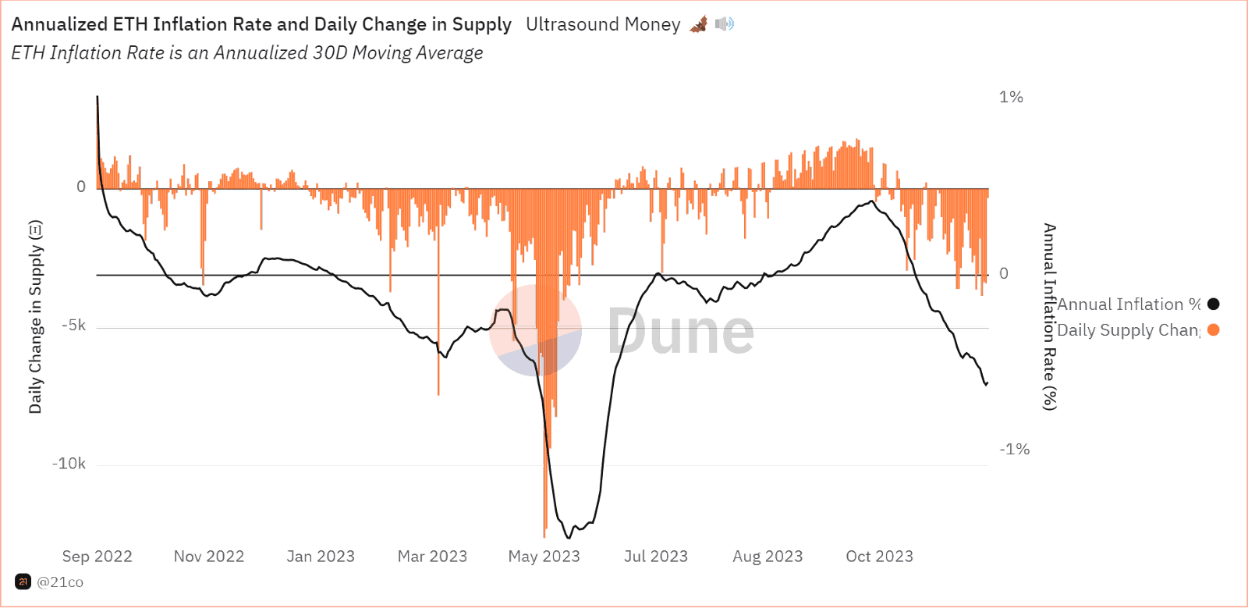
In less than a year, 50 million Ordinals have been inscribed on Bitcoin’s witness data, leveraging the Taproot upgrade launched in November 2021 and the Segregated Witness, or SegWit, upgrade launched in 2017. Bitcoin miners have been accruing revenue on the back of this new evolutionary roadmap; the hash price reached a 19-month high towards the end of 2023. Bitcoin miners derive revenue from issuance and transaction fees, which inscriptions have at peak times represented over 40%, as shown in the figure above.
The consolidation around Ethereum and Solana’s resurrection
After Ethereum's historic transition to a Proof-of-Stake (PoS) consensus mechanism in September 2022, the network entered its next significant phase with the implementation of the Shapella upgrade on April 12. This milestone allowed users to withdraw their staked ETH from the beacon chain after approximately ~2.5 years, constituting one of the major de-risking events in Ethereum’s history by reducing liquidity risks for investors. Since April, Ethereum’s staking ratio has surged from around 15% to approximately 24%, transforming ETH’s staking yield into a digital bond equivalent. Furthermore, the Ethereum ecosystem witnessed a brief surge in activity in May, fueled by memecoin mania, leading to the network's first-ever deflationary turn due to increased transactional and burn activity. Subsequent deflation occurred again as speculative excitement surrounding anticipated ETFs spurred heightened network activity in Q4.

That said, the subdued on-chain activity observed through the 18-month bear market resulted in liquidity reduction and the departure of retail participants from alternative smart-contract platforms. Thus, liquidity became concentrated within the Ethereum ecosystem, drawing in the remaining users and leaving little room for Ethereum's competitors to battle for. In response to this shift, some of Ethereum's scaling solutions, such as Optimism, Arbitrum, ZKSync, and Polygon, developed modular frameworks enabling projects to transform their applications into standalone networks aligned to their specific business requirements, while remaining anchored to Ethereum's security.
Apart from Bitcoin and Ethereum’s narratives, Solana stood out as the exception in 2023 due to its noteworthy recovery. Initially dismissed after the FTX collapse, which saw a substantial portion of Solana's treasury deposited into the exchange, along with significant holdings by Alameda and FTX, the outlook for Solana appeared bleak. Despite this, the network defied expectations and embarked on rebuilding its on-chain ecosystem, which is now flourishing. While the recovery of SOL's price could be attributed to mean reversion from overselling earlier in the year, as it grew by almost tenfold from the lows, the network experienced a significant boost on the back of several mainstream integrations such as Visa expanding its stablecoin settlement capabilities on the blockchain, Shopify’s partnership with Solana Pay and Paxos gaining regulatory approval to expand USDP onto Solana.

Pivotal developments were also revealed at Solana’s annual conference, including a new validator client addressing single points of failure on the software layer (Firedancer), and an AWS node deployment for simplified validation operations. Further, the ecosystem's growth was fueled by a surge in exchange activity (Jupiter, Orca, Raydium), money market protocols (MarginFi, Kamino), and Liquid Staking solutions, which we will discuss deeper in the next section, like MarginFi and BlazeStake. Nevertheless, Solana's resurgence is a testament to its robustness and resilience in the ever-changing crypto environment. This can be witnessed below, with the active users surging recently to reach an all-time high, driven by the excitement around meme coins and airdrop opportunities like Jito.
The rise of liquid staking and tokenization
Two application categories experienced remarkable growth throughout 2023 on the back of crypto’s refining infrastructure, the first of which is Liquid Staking Derivatives. LSDs transform staked assets into tradable derivatives, which is crucial for several reasons. Firstly, they enable users to engage in staking across multiple chains without locking their capital. Users deposit staking assets into a smart contract, receiving an IOU receipt token representing deposited capital and daily accrued yield. This unique functionality allows users to simultaneously benefit from staking and use the receipt token as collateral in DeFi for activities like lending and borrowing.
Secondly, LSDs lower barriers of entry for retail investors, particularly within the Ethereum ecosystem. Users can deposit any amount of tokens, eliminating the need for the mandatory 32 ETH, while bypassing lengthy unbonding periods seen in networks like Cosmos (21 days). This flexibility amplifies overall network participation and enhances its security. Lastly, LSDs offer a user-friendly staking mechanism without requiring technical expertise, operating in a non-custodial manner that avoids dependence on centralized platforms. Ethereum's liquid staking sub-industry experienced a significant surge, growing from $7.5 billion to $27 billion in 2023. This boom, fueled by excitement for ETH staking and the flexibility to withdraw capital post-Shapella upgrade, notably benefited Lido, with stETH's market capitalization soaring from $5 billion to $20 billion. However, the momentum also spilled over to Solana as the two leading LSD solutions Marinda Finance, Jito and BlazeStake grew by ~1000%, ~14,000% and ~24,000%, respectively, year-to-date.
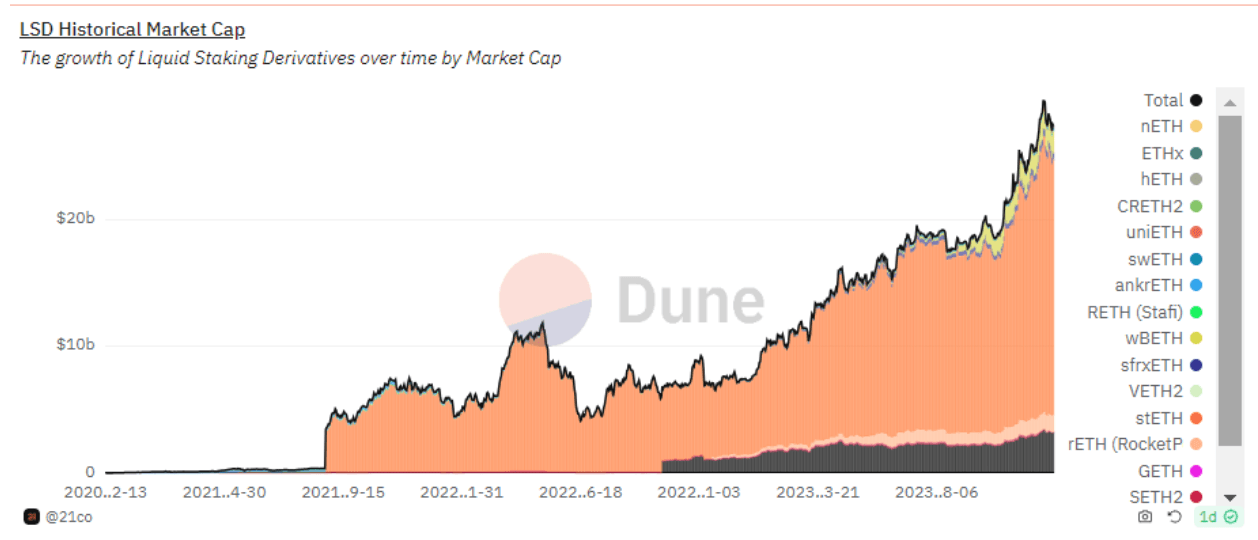
The second category is tokenization, the process of creating digital representation for real-world assets using public networks like Ethereum and Polygon. Although stablecoins are considered the earliest implementation of tokenization as they presented digital dollars on-chain with the examples of USDT and USDC, the technology has been going through an expansionary phase, tackling a wider spectrum of assets.
For instance, government securities in the form of U.S. treasury grew the most this year, with a roughly 600% increase throughout 2023. The trend was leveraging the multi-decade high-interest rate regime to onboard sustainable yield to the crypto economy, which enabled money market protocols, such as Maker, to strategically allocate users’ dollar deposits into US Treasury bills and yield a resilient war chest. This is corroborated by the fact that Maker’s revenue currently exceeded the levels at the peak of the bull market in 2021. Conversely, it granted smaller protocols like Ondo Finance and OpenEden the opportunity to offer tokenized yield on-chain for users wanting to capitalize on the risk-free rate without withdrawing their capital from crypto.
Further, the advantages offered by blockchain-based solutions, including cost efficiency and democratized access to traditionally exclusive industries, spurred the growth of smaller sub-sectors. This phenomenon manifested in the initiating growth of sectors like Real Estate, Private Funds, and Equities, opening doors for wider public participation in industries that were historically challenging to access.
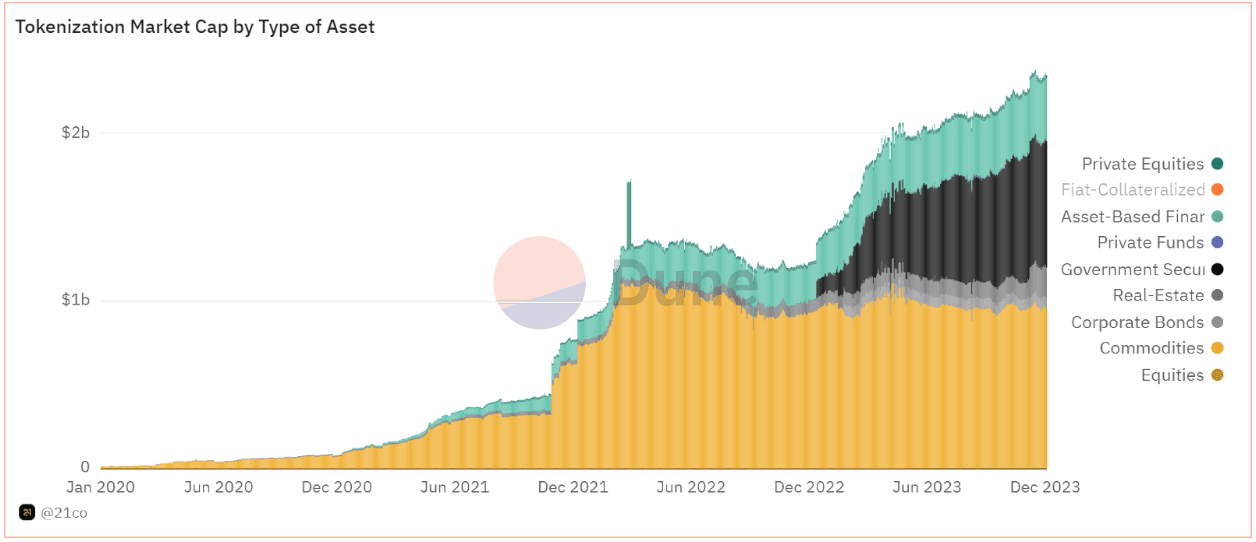
In that realm, a few large financial institutions, such as Franklin Templeton and Societe Generale, launched bonds on public blockchains for increased transparency, traceability, and streamlined transaction processes, while saving up to 65% of traditional issuance costs alone. In another noteworthy initiative, JP Morgan and Apollo Global collaborated on a network and asset-agnostic portfolio management solution. This proof of concept empowers fund managers to tokenize portfolios using JP Morgan's ONYX and the Oasis Pro asset-issuing platform, while leveraging Axelar and Layer Zero interoperability protocols to seamlessly exchange and rebalance portfolios across various blockchains, bridging EVM and non-EVM, private and public chains. The experiment was done to improve operational efficiency by automating over +3000 operational steps while it helped reduce costs by 20% via expediting programmatic settlement.
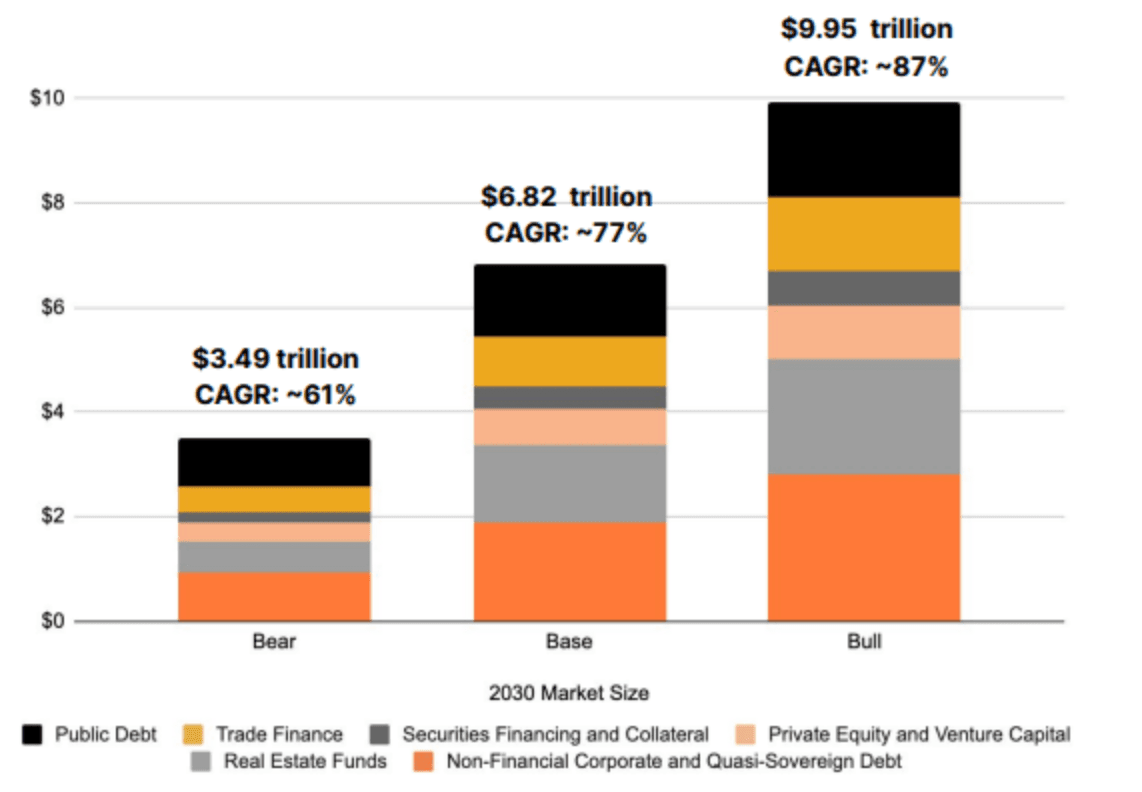
All in all, with an expected market size to reach somewhere between $3.5T and $10T by 2030, we anticipate the sub-industry to propel forward over the coming years. However, for a deeper dive into the landscape of tokenization, we recommend checking our comprehensive report covering the emerging industry.
The evolution of interoperability
Building on the previous example, the rise of tokenization in 2023 was fueled, to some extent, by the maturity of interoperability. Given the inherent incompatibility among different blockchains, interoperability facilitates value and information exchange across diverse blockchains. Consequently, it fosters an interconnected ecosystem of applications and assets, relieving users of concerns about the hosting network for their desired applications. This abstraction on the backend is vital for realizing the vision of a truly global financial system that accommodates a broad spectrum of assets, even those traditionally deemed incompatible. While crypto’s underlying grid is not yet invisible, notable solutions like Chainlink's Cross Chain Interoperability Protocol (CCIP) and Circle’s Cross Chain Transfer Protocol (CCTP) have emerged in 2023, marking strides toward making this vision a reality.
First, CCTP allows for native transfers of USDC across networks using the burn and mint mechanism, the equivalent of ETFs’ creations and redemptions mechanism. Circle’s approach is superior as it unifies liquidity across the different blockchains by using a standardized version of USDC and prevents the reliance on the vulnerable traditional bridges utilizing the lock-and-mint mechanism, which is seen as a honeypot for hackers, which saw the exploitation of more than $2B so far. Alternatively, CCIP is an Interblockchain communication protocol connecting seven different networks, which can be best considered a bridging standard rich with security features to offer a more robust infrastructure.
In the realm of tokenization, Chainlink played a pivotal role in various experiments throughout 2023. Notably, a collaboration with SWIFT and major financial institutions like BNP Paribas, BNY Mellon, and CitiBank utilized CCIP as an enterprise abstraction layer. This streamlined access to multiple networks through SWIFT's messaging infrastructure, leading to reduced operational challenges and investment required for institutions to support the development of tokenized assets, while preventing financial institutions from having to modify their legacy systems by relying on CCIP. Vodafone also conducted a worthy initiative employing CCIP, creating an interconnected system for exchanging digitized trading documents dispersed across multiple blockchains, overcoming traditional system fragmentation and helping Chainlink target the $32T global trade industry. Although Chainlink was able to accrue only close to $250K since the inception of CCIP, we expect the technology to be one of the biggest revenue drivers going into 2024, due the wide applicability of interoperability and as the standard gains widespread market adoption.
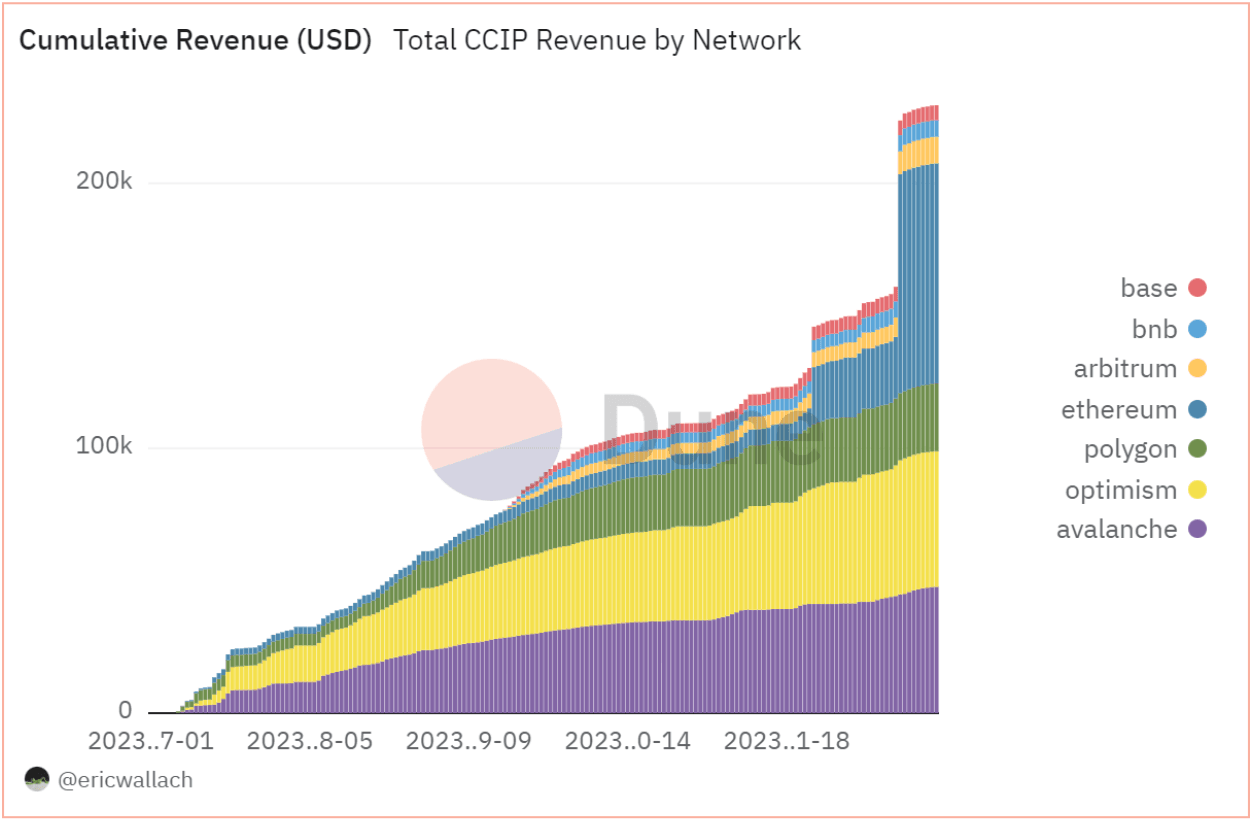
2023: the year of settlements and a new precedent
In 2022, Binance’s stablecoin BUSD was the fastest-growing between USDC and USDT and continued to gain traction, especially after Binance's decision to automatically convert USDC to BUSD to enhance users' liquidity and capital efficiency. In February 2023, the Securities and Exchange Commission (SEC) cracked down on Paxos and ordered it to stop issuing BUSD, the third-largest centralized stablecoin by market cap, claiming it’s an unregistered security.
In June, panic selling drained the cryptoassets market in response to a new lawsuit filed by the SEC against Binance for operating an unregistered national securities exchange, broker-dealer, and clearing agency. The charges also included allegedly misusing user funds and offering and selling unregistered securities, among other allegations. Fast forward to November, Binance paid the Department of Justice (DOJ) $4.4 billion in settlement, with the founder and former CEO Changpeng Zhao facing 18 months in prison, with the sentence to be determined in February. Almost instantaneously, the Chicago Mercantile Exchange (CME) surpassed Binance in BTC futures open interest for the first time, a big indicator of institutional money investing in the asset class.
Toward the end of 2022, we expected the DEX to CEX ratio to increase, which we saw in 2023, especially in May when volume on DEXes increased by 21.6%. This all-time high was primarily due to the market sentiment following the ongoing lawsuits against Binance and Coinbase.
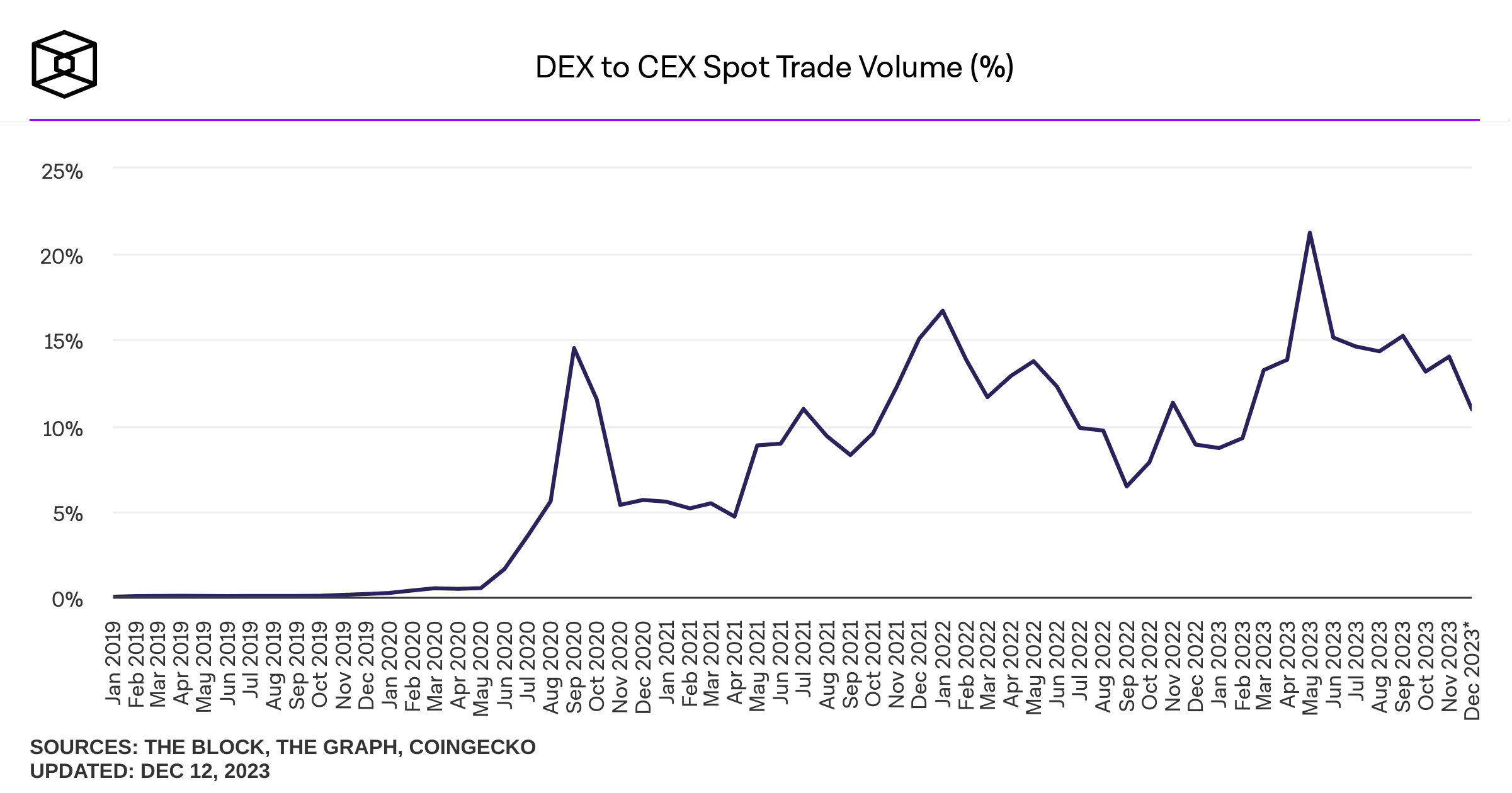
On another note, Ripple’s long dispute with the SEC reached a resolution in 2023. In July, a U.S. court made an inconclusive decision in the Ripple case, dating back to 2020 when the securities regulator accused the company of selling unregistered securities, represented by its XRP token, which has soared by ~80% over the past year.
U.S. District Court Judge Analisa Torres issued a summary judgment opinion holding that the XRP token, by itself, was not a security under U.S. law. Ripple’s XRP token soared by ~80% over the past year. The SEC filed an interlocutory appeal against the inconclusive summary order that Federal Judge Analisa Torres issued on July 13. The appeal primarily objected to the court’s view that the “programmatic sales” of XRP (on exchanges) are not considered securities, highlighting a disagreement among district courts regarding the controlling issues. In response, XRP fell by 17.5% over the following week. On October 4, the judge ordered that the SEC was not allowed to appeal the judge’s order. What’s next?
- By February 12, 2024, the parties shall complete remedies-related discovery.
- By March 13, 2024, SEC shall file its brief with respect to remedies;
- By April 12, 2024, Ripple shall file its opposition;
- By April 29, 2024, SEC shall file its reply, if any.
Ripple has strengthened its brand as a cross-border payments solution: In March 2023, the company launched a platform for CBDC issuance for governments to maintain the lifecycle of their digital currencies. If successful, this may be its leverage for potential crackdowns in the U.S. Moreover, Ripple has succeeded at forging strategic partnerships globally to make it resistant to regulatory headwinds. As for altcoins, we expect crypto companies with similar business models as Ripple to cite this unprecedented regulatory win to defend their “programmatic sales” in potential future enforcement actions. In the same manner, altcoins (such as SOL and ADA), are more susceptible to having their performances impacted as the court procedures develop toward the finish line, almost mirroring XRP’s performance.

